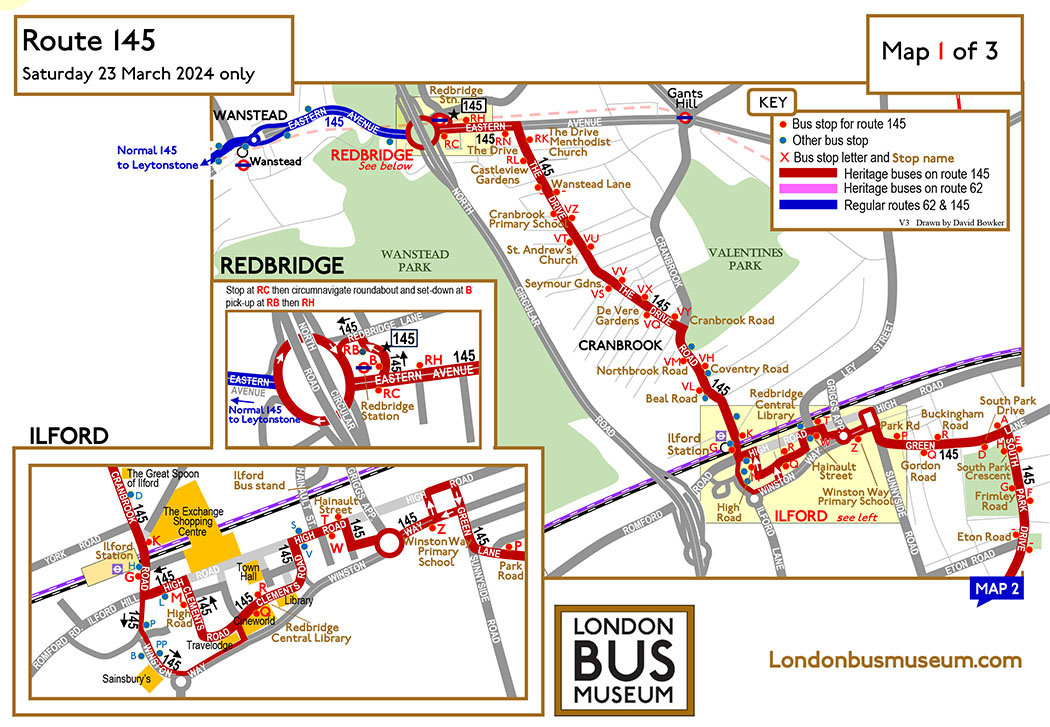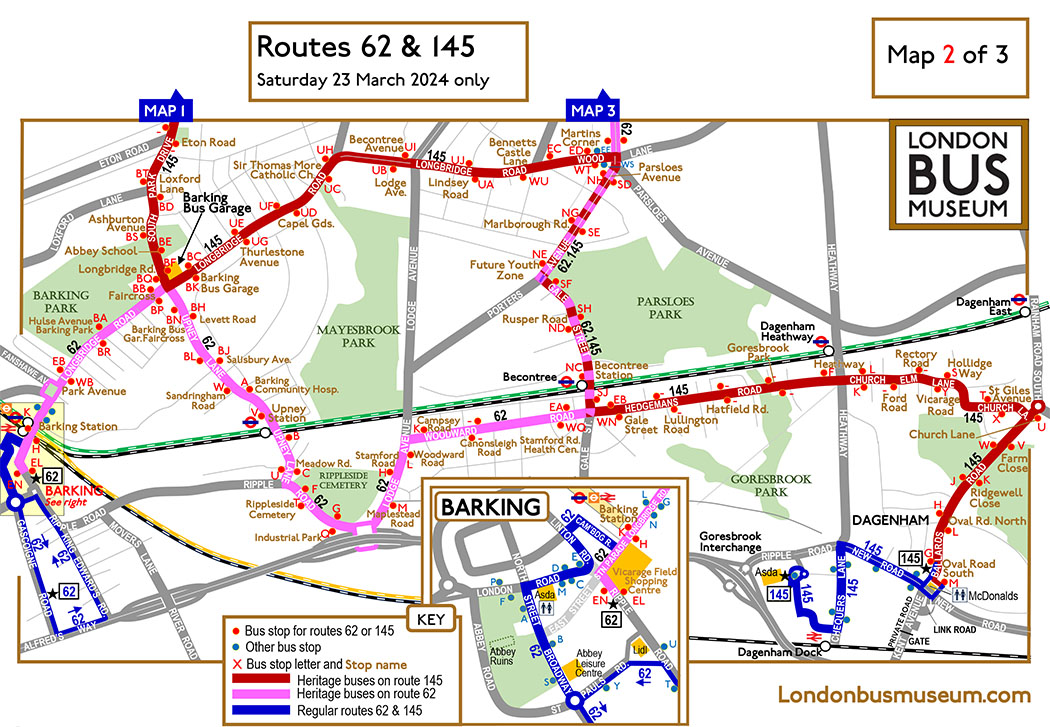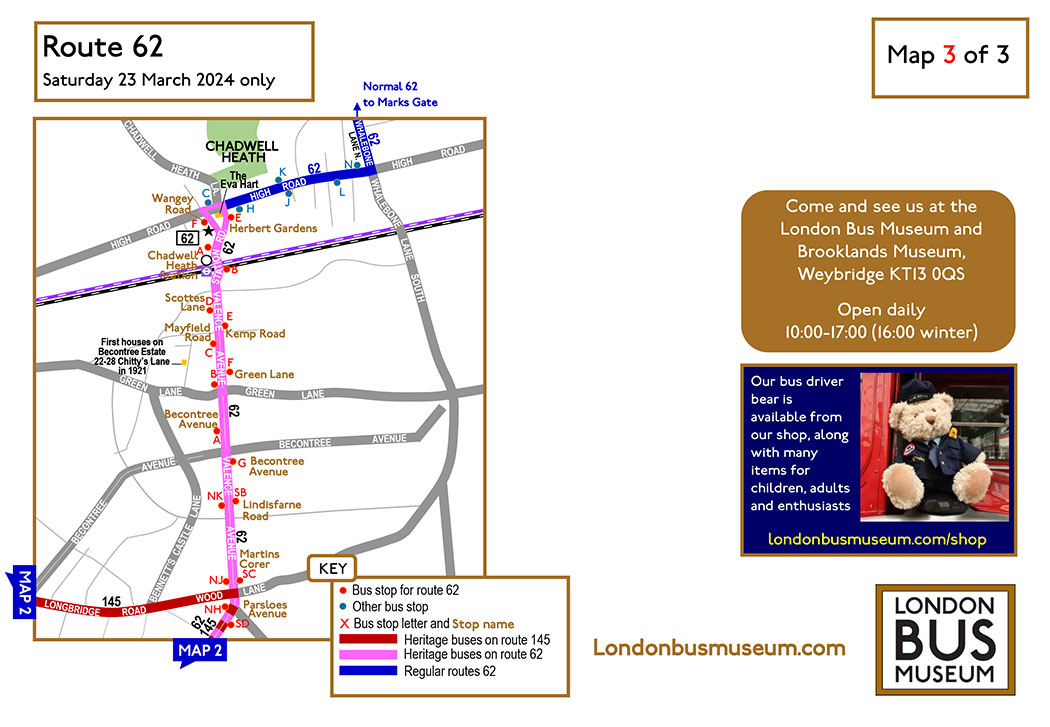

23rd March 2024 : Ride free on old buses in service on London bus routes 62 and 145!
Open-platform buses with real conductors will run between Redbridge and Dagenham (route 145), and between Chadwell Heath and Barking (route 62).
No need to book, just turn up at a bus stop and put out your hand!
Buses used will mostly be the iconic RT-type, which in the 1950s formed the largest standardised bus fleet in the world, plus their successor the Routemaster. Route 62 from Barking Garage [BK] was the last route to operate the RT-type, and the very last RT in London Transport service turned into the garage on 7th April 1979. (See Route 62 Photo Gallery). There will also be a sprinkling of more modern types, albeit long-gone from London streets. A very special visitor with be the Museum's wartime Guy Arab G351 running on the 145. But please remember that all vehicles planned to perform are subject to change or cancellation.
Plus ... In support of MacMillan fundraising, our friends at Stagecoach London will be holding an Open Day at Barking Garage on the same day to celebrate the garage's centenary. It will be open between 11am and 4pm with visiting/vintage vehicles on display, trade stands and a range of branded event merchandise on sale. Routes 62 and 145 both pass the garage.
21st March: Route 62 Timetable v4, Route 145 Timetable v4, and 62 & 145 Bus List v5 added.
- Routes 62 & 145 Heritage Day flyer [PDF]
- Route 62 - a brief history
- Route 62 - photo gallery
- Route 145 - a brief history
- Route 145 - photo gallery
- Routes 62 & 145 - event maps
- Route 62 timetable v4 [PDF]
- Route 145 timetable v4 [PDF]
- Bus List v5 [PDF]
Check back for further updates and follow us on Facebook
... and ...
- Route 406 Heritage Day on Sunday 9th June 2024
- Route 61 Heritage Day on Saturday 14th September 2024
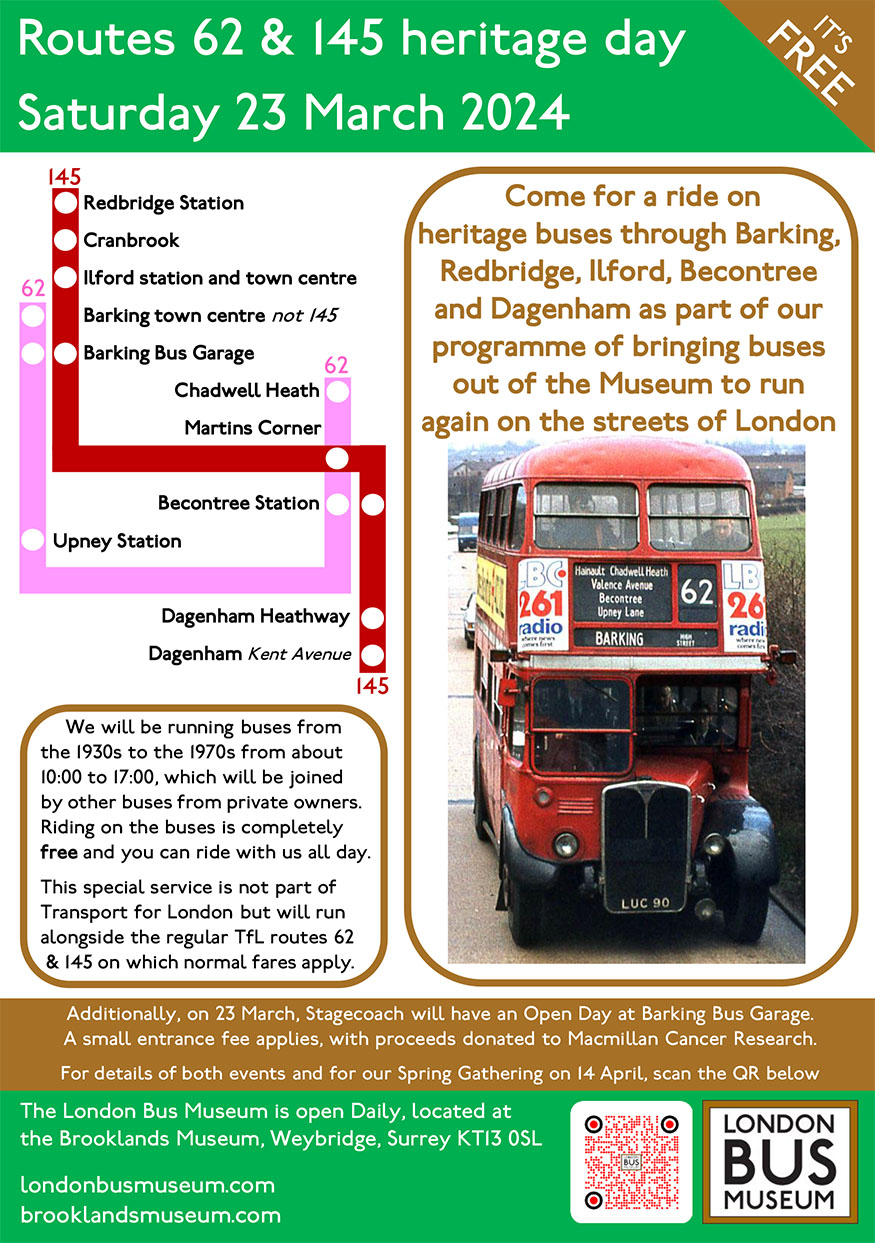
A Brief History of Barking Bus Route 62
Unlike the 145, which started over 100 years ago, the 62 is a relative new-comer, having started in Barking in January 1935. It was introduced as a route from Barking (Westbury Hotel) to Little Heath via Longbridge Road and Goodmayes Lane, almost none of which it covers today. Initially worked by Barking Garage (BK), which the route passed, using three six-wheeler LT double-deckers, the allocation was swapped to Upton Park (U) in March 1936 in exchange for BK taking full charge of trunk route 23, then moved again on weekdays to Athol Street Poplar (C) a year later, now using more modern STLs.
Then in January 1938 the route was extended east along Ripple Road and north via Becontree Station and Martins Corner to Chadwell Heath, creating a U-shaped route. Operation returned to BK, now needing 8 LTs. Sunday operation was added in May 1938, although only between Barking and Chadwell Heath. The first extension north from Chadwell Heath was on summer Sundays, when the route continued via Whalebone Lane North to Chigwell Row, then out in the country.
The summer extensions continued throughout the Second World War, at the end of which BK replaced the LTs on the route with utility-bodied G-class Guys. At the beginning of 1947, the route was extended on weekdays over the Sunday route to Chigwell Row, whilst Sunday operation continued only in the summer. Barking started receiving new RTLs in early 1949 and from December replaced the Guys on the 62.
The route changed again in April 1952, turning left before Chigwell Row into New North Road and terminating at The Old Maypole, Fencepiece Road, Barkingside. A further extension south via Gants Hill to Ilford Station followed in February 1954, creating a spiral shape round Little Heath and bringing in Seven Kings Garage (AP) with 5 RTLs to join 13 from BK. BK exchanged its RTLs for RTs on 26 November 1958.
February 1960 finally saw the creation of the route that was to become famous, with the whole of the original route (Barking to Little Heath) withdrawn and the route from Chadwell Heath diverted from the eastern end of Ripple Road to run via Upney Station to Barking Garage, then into Barking centre to terminate at St Paul’s Road. The well-known journeys to Creekmouth Power Station were first introduced (on Sundays) in July 1969. The loop in Barking to Gascoigne Estate was added in March 1973, but the route was withdrawn between Ilford and Barkingside in March 1977.
The route achieved immortality on Sunday 7 April 1979, when the last RT in London Transport service ran in to Barking Garage at 11am, with RT624 being the last RT replaced on the road by Routemasters during the morning.
![RT3251 [David Bowker] RT3251 [David Bowker]](https://www.londonbusmuseum.com/wp-content/uploads/2023/11/A-62-RTA265B.jpg)
![RT4633 [David Bowker] RT4633 [David Bowker]](https://www.londonbusmuseum.com/wp-content/uploads/2023/11/A-62-RTA261A.jpg)
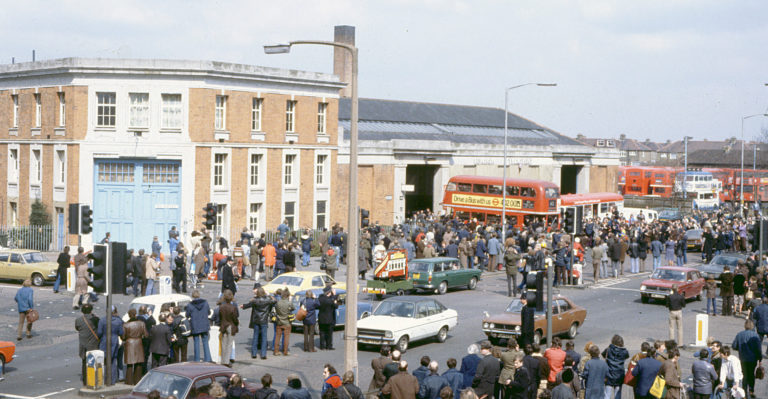
![EnsignBus B226 [David Bowker] EnsignBus B226 [David Bowker]](https://www.londonbusmuseum.com/wp-content/uploads/2023/11/A-62-LTC068B.jpg)
![EnsignBus RT3062 - Woodward Road - 5 Apr 1987 [Mike Harris] EnsignBus RT3062 - Woodward Road - 5 Apr 1987 [Mike Harris]](https://www.londonbusmuseum.com/wp-content/uploads/2024/02/A-62-Ensign-RT3062-Woodward-Road-Mike-Harris-05-04-87-768x512.jpg)
The RMs had a brief stay on the route, being replaced in January 1980 by T class Leyland Titans, initially crew-operated. One-person operation followed on 23 April 1983. Meanwhile, the route had been shortened in September 1982, cut back to Hainault daily and further to Marks Gate in the evening and on Sundays; the Creekmouth journeys also ceased at this date. The route was reinstated in the peaks as far as Gants Hill in June 1986.
Having been the sole operator of the route since the withdrawal of AP’s minority share in 1963, BK and London Buses lost the route on its first tender from 17 January 1987. The winner of a five year contract was EnsignBus, operating from Purfleet and initially using blue and silver ex-London DMSs, assisted from time to time by RT3232 and RT3062. Other buses appeared during their term of operation, including the route’s first single-deckers in the form of Leyland Nationals, and the business was acquired by Hong Kong Citybus and renamed Ensign Citybus. In December 1990, the route was again withdrawn between Marks Gate and Gants Hill, but extended during shopping hours to Collier Row.
The next tender saw the route return to BK, now under the operation of London Buses’ subsidiary East London, from 23 November 1991, at which point the route took on its current form of Marks Gate to Barking Gascoigne Estate. Operation was initially with Ts, which were replaced in March 1993 by small single-deck midibuses running at an increased frequency. East London was acquired by Stagecoach in September 1994 and 12 low-floor Darts replaced the 11 midibuses in 1999.
With one working having been doubledeck operated from 2011, the Darts were replaced by Optare Versas (purchased while East London was not owned by Stagecoach), but the route converted back to double-deck with new Enviro400MMCs in April 2016, now also seeing a sprinkling of older Enviro400s.
The route was retained by BK in April 2023, the route now having been operated wholly or primarily by BK since 1938, with the exception of the period of the EnsignBus contract.
Photo Gallery
Hover on photo for caption
A brief history of London bus route 145
The story of bus route 145 is inextricably linked with the development by London County Council (LCC) of housing at Becontree, Dagenham and Barking, akin to the creation of a new town, after the first world war. Barking garage has operated the 145 for 95 of the 100 years since it opened.
When the London General Omnibus Co’s Barking garage (BK) opened on 9 January 1924, it took over operation of trunk route 23 (Marylebone - Dagenham) from Upton Park (U) and local route 25D (Cranbrook Park – Becontree) from Forest Gate (G), and introduced new route 23B (Marylebone – Barking Garage). Operation was with open-top, solid tyred NS buses; routes 23/23B needed 52 buses, the 25D another 5.
Route 25D had started operation on 31 October 1923, running on Monday to Saturday between Cranbrook Park (then the edge of the built-up area, north of Ilford) and Becontree (Chittys Lane) via Ilford and Green Lane. Chittys Lane was the site of the first LCC homes in Becontree.
Possibly because the two termini were also connected with Ilford by the 25B and 25A (respectively), the 25D was suspended between June and October 1924, but soon after it recommenced, now running weekday peaks hours and Saturday, it was extended northwards to what is now known as Gants Hill. In the widespread route renumbering on 1 December 1924, the 25D was renumbered 145.
By December 1925, the route additionally ran during the day on weekdays. As Becontree expanded, the route was extended east and south – in February 1926, via Bennetts Castle Lane to Longbridge Road, in August 1927 further along Wood Lane to Five Elms, in January 1932 to Dagenham (Oxlow Lane) and finally in February 1937 to Dagenham (New Road) via Porters Avenue and Heathway.
![Bluebird LT999 [AlanCross - LBM Collection] Bluebird LT999 [AlanCross - LBM Collection]](https://www.londonbusmuseum.com/wp-content/uploads/2023/11/A-145_BluebirdLT999_AlanCross_LBM4038.jpg)
Also in February 1926, the main route was extended north from Gants Hill via South Woodford to Woodford Wells. On summer Sundays (and some years Saturday afternoons), from 1926 to 1931, the route was further extended to Epping Forest; the Sunday services were run by G or Seven Kings (AP) garages. In October 1932, the full route was extended further north from Woodford Wells to Chingford (Royal Forest Hotel). Covered top NSs had replaced the open-toppers from 1928, and whilst other garages gradually introduced newer types at weekends, it was not until 1936 that enough LTs became available for BK to operate them on the 145 on weekdays; Saturdays had been partly LT-operated since 1934 and Sundays were operated by Upton Park (U) using LTs from 1932, then TD-class Leyland Titans from 1935. U also shared the weekday operation from 1937, converting back to LTs in 1938.
![Guy Arab G176 at Dagenham [C Carter, LBM Collection] Guy Arab G176 at Dagenham [C Carter, LBM Collection]](https://www.londonbusmuseum.com/wp-content/uploads/2023/11/A-145_G176_Dagenham_CCarter_LBM4047.jpg)
![RTW300 - Dagenham New Rd_ [Edward Shephard - LBM Collection] RTW300 - Dagenham New Rd_ [Edward Shephard - LBM Collection]](https://www.londonbusmuseum.com/wp-content/uploads/2023/11/A-145_RTW300_DagenhamNewRd_EdwardShephard_LBM6014.jpg)
Wartime brought further changes. From December 1939, BK took back full operation on Monday to Saturday, certain peak journeys being extended to Ford Works. G worked the route on Sundays, using STLs. From October 1941, some journeys were diverted to run to Dagenham Dock. AP replaced G on Sunday from 1942 and provided LTs all week alongside BK; later that year U joined in on weekdays. BK replaced the now elderly LTs with new utility G-class Guys from June 1945, although LTs continued to appear until 1949; U’s contribution became a mix of LTs, Gs and STs from 1946.
The all-conquering RT family made a tentative appearance with a working from U off the 15 in October 1948, followed by a Sunday allocation from AP in June 1949 (replaced by RTLs starting in the same month) and a BK RTL working off the 148 from August. But the main influx came in September, with more RTLs for BK and more RTs for U, sweeping away all that came before – with the exception of an occasional Guy from BK working off the peak hour 23B, which converted to RTW in April 1950. All three classes of RT were now scheduled on the 145, a situation which continued until the RTWs were moved away to work in central London in 1951, at which point the 145 reached its maximum allocation of 16 buses on weekdays, providing a bus every 12 minutes.
The route continued unchanged, running from Chingford (Royal Forest Hotel) to Dagenham (New Road) with journeys to Dagenham Dock and Ford Works, until October 1963. Meanwhile, in 1958, BK had converted from an RTL to a RT garage. The route was now entirely RT-operated, from 1960 worked with 13 RTs by BK with a smaller allocation of 9 RTs from U.
Change came in October 1963, when the section of route north of Ilford was (except for school journeys) replaced by new route 179 and Sunday operation replaced (until January 1966 only) by new route 145A running from Leytonstone via Redbridge and Ilford. Sunday operation was withdrawn entirely from July 1969 and by 1974 the route required only 9 RTs.
The RT era ended with transition to one-man-operation (as it then was) by DMSs on 20 April 1974, giving way in turn to T-class Leyland Titans in May 1980. The journeys to Dagenham Dock were withdrawn in February 1985, although a few Ford Works journeys continued until March 2001.
![Fleetline DMS692 - 7 July -1977 - Dagenham Chequers [Colin Fradd] Fleetline DMS692 - 7 July -1977 - Dagenham Chequers [Colin Fradd]](https://www.londonbusmuseum.com/wp-content/uploads/2023/11/A-DMS692_145_070777-Dagenham-Chequers-Colin-Fradd.jpg)
![RT508 [Jim Andress - LBM Collection] RT508 [Jim Andress - LBM Collection]](https://www.londonbusmuseum.com/wp-content/uploads/2023/11/A-145_RT508_JimAndress_LBM11826.jpg)
![T143 - 1986 [Colin Fradd] T143 - 1986 [Colin Fradd]](https://www.londonbusmuseum.com/wp-content/uploads/2023/11/A-Batch036-c1986-36a-CFradd.jpg)
A more dramatic transformation came in the second round of tenders by London Buses with the award of the route to EnsignBus of Purfleet, effective 21 June 1986, with the route reverting to DMS operation but in blue and silver livery. On a few notable occasions, the DMSs were joined by blue and silver RT3232; in 1990, the Ensign London bus operations passed to CNG Group of Hong Kong and traded as Ensign Citybus, by which time more modern types were in use. But at contract renewal, the routes passed back to the London Buses subsidiary East London on 22 June 1991, worked again by BK.
With the Ensign contract in 1986 had come an extension northwest from Ilford to Redbridge Station and a re-routing in Barking to pass BK via South Park Drive instead of using Bennetts Castle Lane. This established today’s routing between Redbridge and Dagenham that will be recreated on 23 March 2024. On reversion to operation from BK in 1991, the route was extended west from Dagenham (New Road) to run to Dagenham Asda. Initially reverting to T-class operation, the route was extended again in July 1993, west from Redbridge to Leytonstone (retracing the Sunday operation on the 145A in the 1960s) and converted to single-deck midibus operation. Sunday operation recommenced from this time. In 1994, East London was acquired by Stagecoach plc.
Double-deck operation was reintroduced on 30 August 2003, using 15 TA Tridents. These were in turn replaced in June 2011 by Alexander Dennis Enviro400s, now joined by hybrid versions of that type, with a requirement for 17 buses and running every 12 minutes. The most recent contract renewal at BK was in April 2023.
![Ensignbus RT and DMS - Dagenham [David Flett] Ensignbus RT and DMS - Dagenham [David Flett]](https://www.londonbusmuseum.com/wp-content/uploads/2023/11/A-145-Ensign-RT-and-DMS-Dagenham-David-Flett-scaled.jpg)
Photo Gallery
Hover on photo for caption
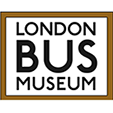
![RT2541 [David Bowker] RT2541 [David Bowker]](https://www.londonbusmuseum.com/wp-content/uploads/2023/11/A-62-RTA267A.jpg)
![RT2240 [David Bowker] RT2240 [David Bowker]](https://www.londonbusmuseum.com/wp-content/uploads/2023/11/A-62-RTA238A.jpg)
![RT1790 [David Bowker] RT1790 [David Bowker]](https://www.londonbusmuseum.com/wp-content/uploads/2023/11/A-62-RTA229B.jpg)
![RT1301 [David Bowker] RT1301 [David Bowker]](https://www.londonbusmuseum.com/wp-content/uploads/2023/11/A-62-RTA224A.jpg)
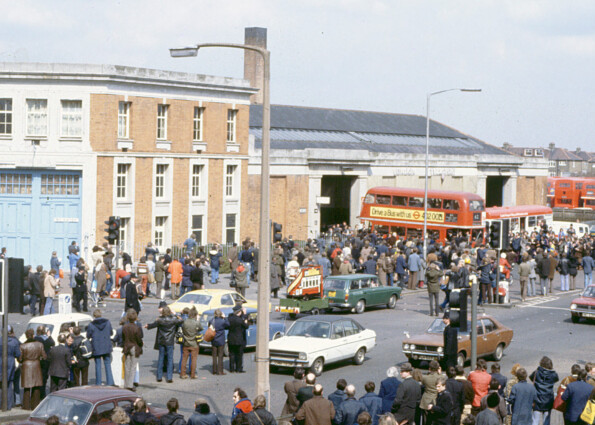
![RM350 [David Bowker] RM350 [David Bowker]](https://www.londonbusmuseum.com/wp-content/uploads/cache/2023/11/A-62-RMA214B/2080709322.jpg)
![T114 [David Bowker] T114 [David Bowker]](https://www.londonbusmuseum.com/wp-content/uploads/cache/2023/11/A-62-LTA387B/4051939378.jpg)
![EnsignBus ex-LCBS Atlantean 224 [David Bowker] EnsignBus ex-LCBS Atlantean 224 [David Bowker]](https://www.londonbusmuseum.com/wp-content/uploads/2023/11/A-62-LTC189A.jpg)
![EnsignBus Leyland-National 501 - Gascoigne Estate - 15 January 1989 [Mike Harris] EnsignBus Leyland-National 501 - Gascoigne Estate - 15 January 1989 [Mike Harris]](https://www.londonbusmuseum.com/wp-content/uploads/cache/2024/02/A-62-National-Ensign-501-Gascoigne-Estate-Mike-Harris-15-01-89/4105578257.jpg)
![EnsignBus RT3062 - Woodward Road - 5 Apr 1987 [Mike Harris] EnsignBus RT3062 - Woodward Road - 5 Apr 1987 [Mike Harris]](https://www.londonbusmuseum.com/wp-content/uploads/cache/2024/02/A-62-Ensign-RT3062-Woodward-Road-Mike-Harris-05-04-87/3398266567.jpg)
![EnsignBus Dennis Dominator 255 [David Bowker] EnsignBus Dennis Dominator 255 [David Bowker]](https://www.londonbusmuseum.com/wp-content/uploads/2023/11/A-62-LTD084B.jpg)
![Capital Citybus Dennis Dominator 263 - Ripple Road - 16 November 1991 [Mike Harris] Capital Citybus Dennis Dominator 263 - Ripple Road - 16 November 1991 [Mike Harris]](https://www.londonbusmuseum.com/wp-content/uploads/cache/2024/02/A-62-Dennis-Dominator-Citybus-263-Ripple-Road-Mike-Harris-16-11-91/930595414.jpg)
![Dennis Dart DW137 -Barking, Cambridge-Road - 17 October 1993 [Mike-Harris] Dennis Dart DW137 -Barking, Cambridge-Road - 17 October 1993 [Mike-Harris]](https://www.londonbusmuseum.com/wp-content/uploads/cache/2024/02/A-62-Dart-DW137-Barking-Cambridge-Road-Mike-Harris-17-10-93/3507586746.jpg)
![Dennis Dart DRL120 -Barking, Cambridge-Road - 15 October 1995 [Mike Harris] Dennis Dart DRL120 -Barking, Cambridge-Road - 15 October 1995 [Mike Harris]](https://www.londonbusmuseum.com/wp-content/uploads/cache/2024/02/A-62-Dart-DRL120-Barking-Cambridge-Road-Mike-Harris-15-10-95/1790146323.jpg)
![Stagecoach London ADL Trident / E400 10173 - Barking, Station Parade - 28 April 2023 [David Harman] Stagecoach London ADL Trident / E400 10173 - Barking, Station Parade - 28 April 2023 [David Harman]](https://www.londonbusmuseum.com/wp-content/uploads/2023/11/A-62-E400.jpg)
![Stagecoach London ADL E400 MMC 10330 - Barking, Station Parade - 28 April 2023 [David Harman] Stagecoach London ADL E400 MMC 10330 - Barking, Station Parade - 28 April 2023 [David Harman]](https://www.londonbusmuseum.com/wp-content/uploads/2023/11/A-62-E400MMC.jpg)
![London Transport RT1987 [LUC 88] ~ Parsloes Park ~ 16 April 1974 [Mike Harris]London Transport RT1987 [LUC 88] ~ Parsloes Park ~ 16 April 1974 [Mike Harris] London Transport RT1987 [LUC 88] ~ Parsloes Park ~ 16 April 1974 [Mike Harris]](https://www.londonbusmuseum.com/wp-content/uploads/cache/2024/01/A008736/4207960066.jpg)
![DMS546 [David Bowker] DMS546 [David Bowker]](https://www.londonbusmuseum.com/wp-content/uploads/2023/11/A-145-LTA118A.jpg)
![T76 [David Bowker] T76 [David Bowker]](https://www.londonbusmuseum.com/wp-content/uploads/2023/11/A-145-LTB343A.jpg)
![T237 [EYE 237V] ~ Ilford Broadway ~ 7 June 1986 [Mike Harris] T237 [EYE 237V] ~ Ilford Broadway ~ 7 June 1986 [Mike Harris]](https://www.londonbusmuseum.com/wp-content/uploads/cache/2024/01/A099115/3330360816.jpg)
![EnsignBus ex-LT DMS B215 [David Bowker] EnsignBus ex-LT DMS B215 [David Bowker]](https://www.londonbusmuseum.com/wp-content/uploads/2023/11/A-145-LTC061A.jpg)
![Ensignbus RT and DMS - Dagenham [David Flett] Ensignbus RT and DMS - Dagenham [David Flett]](https://www.londonbusmuseum.com/wp-content/uploads/cache/2023/11/A-145-Ensign-RT-and-DMS-Dagenham-David-Flett-scaled/1400960465.jpg)
![EnsignBus RT3232 [KYY 961] ~ The Drive ~ 13 Dec 1986 [Mike Harris] EnsignBus RT3232 [KYY 961] ~ The Drive ~ 13 Dec 1986 [Mike Harris]](https://www.londonbusmuseum.com/wp-content/uploads/cache/2024/01/A101708/1329414452.jpg)
![EnsignBus RT3232 [David Bowker] EnsignBus RT3232 [David Bowker]](https://www.londonbusmuseum.com/wp-content/uploads/2023/11/A-145-RTA298B.jpg)
![Ensignbus ex-Leicester Metrobus 275 [FUT 39V] ~ Ilford Station ~ 21 June 1991 [Mike Harris] Ensignbus ex-Leicester Metrobus 275 [FUT 39V] ~ Ilford Station ~ 21 June 1991 [Mike Harris]](https://www.londonbusmuseum.com/wp-content/uploads/cache/2024/01/A146904/3859038103.jpg)
![Ensign Citybus RM429 -Dagenham Fords Main Works - 25 June 1991 [Mike Harris] Ensign Citybus RM429 -Dagenham Fords Main Works - 25 June 1991 [Mike Harris]](https://www.londonbusmuseum.com/wp-content/uploads/cache/2024/02/A-145-Ensign-Citybus-RM429-Dagenham-Fords-Main-Works-Mike-Harris-21-06-91/114718583.jpg)
![East London Dennis Dart DW154 - Ilford, Clements Road - 20 March 1993 [Mike Harris] East London Dennis Dart DW154 - Ilford, Clements Road - 20 March 1993 [Mike Harris]](https://www.londonbusmuseum.com/wp-content/uploads/cache/2024/02/A-145-Dart-DW154-Ilford-Clements-Road-Mike-Harris-20-03-93/370661557.jpg)
![Stagecoach Dennis Lance LA4 - Ilford-Lane 6 August 1995 [Mike Harris] Stagecoach Dennis Lance LA4 - Ilford-Lane 6 August 1995 [Mike Harris]](https://www.londonbusmuseum.com/wp-content/uploads/cache/2024/02/A-145-Lance-LA4-Ilford-Lane-Mike-Harris-06-08-95/2376566993.jpg)
![Stagecoach DAF Delta DA31 - Ilford Station -11 May 1997 [Mike Harris] Stagecoach DAF Delta DA31 - Ilford Station -11 May 1997 [Mike Harris]](https://www.londonbusmuseum.com/wp-content/uploads/cache/2024/02/A-145-Daf-Delta-DA31-Ilford-Station-Mike-Harris-11-05-97/3929819003.jpg)
![Stagecoach London ADL Trident / E400 19797 - Ilford, Clements Road - 21 June 2013 [David Harman] Stagecoach London ADL Trident / E400 19797 - Ilford, Clements Road - 21 June 2013 [David Harman]](https://www.londonbusmuseum.com/wp-content/uploads/2023/11/A-145-E400-1.jpg)
![Stagecoach London ADL E400MMC 10332 -
Ilford, Clements Road - 27 June 2022 [David Harman] Stagecoach London ADL E400MMC 10332 - Ilford, Clements Road - 27 June 2022 [David Harman]](https://www.londonbusmuseum.com/wp-content/uploads/2023/11/A-145-E400MMC.jpg)
